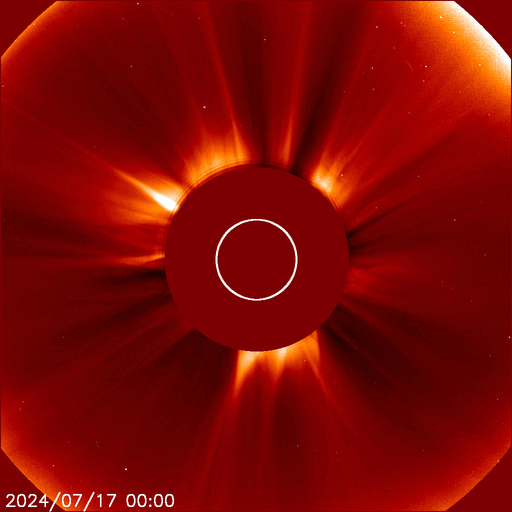Yesterday one of the longest solar prominences seen in years caused the Sun to fire out a major coronal mass ejection (CME). The prominence is estimated to have reached a length greater than the distance between the Earth and the Moon, around 380,000 kilometers (236,000 miles). Although CMEs are common so close to solar maximum, this one stands out a little, both because it looks to be heading straight for Mercury, and because some remarkable images have been captured.
CMEs are the cause of auroras and their associated activity. They occur when solar flares lift magnetic field and plasma from the Sun and fire both into space.
Not all flares, and not even all large flares, produce CMEs, which is one of the things that make solar activity hard to predict. When they do occur the charged particles lifted off the Sun can, if pointed at Earth, be funneled by the magnetosphere towards the poles, where they ionize excite atoms that release light as they return to their ground state.
Mercury has no atmosphere, so until recently, it was thought nothing interesting would happen when a CME hits. However, a year ago today, evidence was published showing it does something that would be just as spectacular as an aurora for anyone who can see in the X-ray part of the spectrum. The CME’s electrons reach the surface unimpeded causing the rocks themselves to fluoresce at X-ray wavelengths, after compressing Mercury’s magnetosphere.
It’s easy to feel as though the Sun took notice, because in March it fired one major CME at Mercury, and now it has sent another towards the little planet.

Sadly NASA’s SOHO only caught part of the event, but it still makes for spectacular viewing.
Imnage Credit: NASA SOHO
Hopefully, this will keep happening because in December next year, the BepiColombo spacecraft will, all going well, enter orbit around Mercury. It has already made three fly-bys of its destination, using the planet’s gravity to adjust its path around the Sun, as it did twice with Venus, to enable eventual orbital insertion. Three more fly-bys are still to come. Data from one of these quick visits was what alerted astronomers to the whole X-ray fluorescence, so if a CME hits while the craft is in orbit the scientific benefits could be enormous. Whether the solar maximum will continue that long remains to be seen.
NASA’s Solar Dynamics Observatory only caught part of the CME, as it was undergoing calibration, but NOAA’s GOES-16 Solar Ultraviolet Imager caught it all, as did NASA’s Solar and Heliospheric Observatory (SOHO), whose images are shown above.
However, all of these were arguably outdone by Argentine astrophotographer Eduardo Schaberger Poupeau. A frequent winner of astrophotography awards, Schaberger Poupreau has plenty of previous solar images on his Instagram, but even among those, the one at the top of this story stands out.
“This afternoon, despite the enormous turbulence of the atmosphere (during winter, my “seeing” is very bad), I managed to photograph a gigantic plasma tongue on the Sun with my H-alpha telescope,” Poupea told Spaceweather.com.
“As I watched, the prominence kept growing and reached an impressive height of more than 380,000 km, more than the distance between the Earth and the Moon! This solar phenomenon was truly spectacular. The gigantic plasma tongue extended like a serpent of fire. The magnitude and beauty of this event left me in awe, reminding me once again of the majesty and power of the universe around us.”
Source Link: Astrophotographer Catches Sun Firing Spectacular Plasma Ejection At Mercury